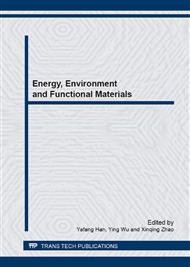[1]
Meeting report: summary of IARC monographs on formaldehyde, 2-butoxyethanol, and 1-tert-butoxy-2-propanol, J. Environmental Health Perspectives. 113 (2005)1205-1208.
DOI: 10.1289/ehp.7542
Google Scholar
[2]
Information on http://www.bjee.org.cn/cn/news.php?news_id=36636.
Google Scholar
[3]
T.N. Obee, Photooxidation of sub-parts-per-million toluene and formaldehyde levels on titania using a glass-plate reactor, J. Environ Sci Technol. 30(1996) 3578-3584.
DOI: 10.1021/es9602713
Google Scholar
[4]
W Liang, J Li, Y Jin, Photo-catalytic degradation of gaseous formaldehyde by TiO2/UV, Ag/TiO2/UV and Ce/TiO2/UV, J. Build Environ. 51(2012)345-350.
DOI: 10.1016/j.buildenv.2011.12.007
Google Scholar
[5]
J Pei, J.S. Zhang, On the Performance and mechanisms of formaldehyde removal by chemi-sorbents, J. Chem Eng. 167(2011)59-66.
DOI: 10.1016/j.cej.2010.11.106
Google Scholar
[6]
R Wang, J Li, OMS-2 catalysts for formaldehyde oxidation: effects of Ce and Pt on structure and performance of the catalysts, J. Catal Lett. 131(2009)500-505.
DOI: 10.1007/s10562-009-9939-5
Google Scholar
[7]
S Yoshika, Oxidatuve decomposition of formaldehyde by metal oxides at room temperature, J. Atomospheric Environment. 36(2002)5543-5547.
DOI: 10.1016/s1352-2310(02)00670-2
Google Scholar
[8]
Y.J. Li, Phenol reagent spectrophotometry method of detecting indoor formaldehyde, J. Laboratory Science. 3(2008)75-77.
Google Scholar
[9]
Z.M.Mo,Y.B. Mo, On the uncertainty of formaldehyde content by using MBTH spectrophotometry, J. Guangxi Sciences. 17 (2010)72-74.
Google Scholar
[10]
K. Toda, Portable system for near-real time measurement of gaseous formaldehyde by means of parallel scrubber stopped-flow absorptiometry, J. Analytica Chimica Acta. 531(2005)41-49.
DOI: 10.1016/j.aca.2004.08.070
Google Scholar
[11]
Q Xu, P Xu, Optimization selection to measure the content of formaldehyde in indoor air by phenol reagent spectrophotometry, Journal of Shandong Institute of Light Industry. 23 (2009)79-83.
Google Scholar
[12]
W Han, Adsorption and decomposition of formaldehyde at room temperature using the adsorbing polymer fibers loaded nano-MnO2, J. Polymer Materials Science and Engineering. 28 (2012)158-162.
Google Scholar
[13]
J.H. Song, Influence factor of test form aldehyde in air by MBTH spectrophotometry, J. Metrology and Measurement Technique. 34 (2007)7-10.
Google Scholar


